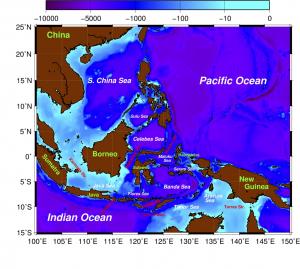New understanding of ocean passageway could aid climate change forecasts
University of Hawaiʻi at MānoaAssociate Specialist, International Pacific Research Center
Talia Ogliore, (808) 956-4531
Public Information Officer, Vice Chancellor for Research
The passageway that links the Pacific Ocean to the Indian Ocean is acting differently because of climate change, and now its new behavior could, in turn, affect climate in both ocean basins in new ways.
UH Mānoa physical oceanographer James Potemra is co-author of a study led by Janet Sprintall of Scripps Institution of Oceanography at UC San Diego. The scientists have found that the flow of water in the Indonesian Throughflow – the network of straits that pass Indonesia’s islands – has changed since the late 2000s under the influence of dominant La Niña conditions. The flow has become more shallow and intense in the manner that water flows through a hose that has become kinked. The study suggests that human-caused climate change might make this characteristic a more dominant feature of the throughflow, even when El Niño conditions return.
Sprintall and colleagues have spent more than a decade understanding the dynamics of the throughflow, an ocean region that acts like a cable sending information between two electronic devices. The Indonesian seas are the only tropical location in the world where two oceans interact in this manner. The throughflow has an effect on the climate well beyond its boundaries, playing a role in everything from Indian monsoons to the El Niño phenomena experienced by California.
“This is a seminal paper on a key oceanographic feature that may have great utility in climate research in this century,” said Eric Lindstrom, a physical oceanography program scientist who co-chairs the Global Ocean Observing System Steering Committee at NASA, which funded Sprintall’s portion of the study. “The connection of the Pacific and Indian oceans through the Indonesian Seas is modulated by a complex circulation, climate variations, and sensitive ocean-atmosphere feedbacks. It’s a great place for us to sustain ocean observations to monitor potential changes in the ocean’s general circulation under a changing climate.”
Sprintall, a physical oceanographer at Scripps Oceanography, said this new research starts a new chapter in the history of the throughflow, one characterized by the changed variables created by global warming.
“Now that we have a better understanding of how the Indonesian Throughflow responds to El Niño and La Niña variability, we can begin to understand how this current behaves in response to changes in the trade wind system that are brought on through anthropogenic climate change,” Sprintall said. “Changes in the amount of warm water that is carried by the throughflow will have a subsequent impact on the sea surface temperature and so shift the patterns of rainfall in the whole Asian region.”
The study, “The Indonesian seas and their role in the coupled ocean-climate system,” appeared in the June 22 advance online publication of the journal Nature Geoscience.
In previous work over the past decade, Sprintall and colleagues from several countries have revised earlier thinking that most of the action in the throughflow was just at the surface where winds and waves interact. In fact, the flow often runs as much as 100 meters (328 feet) below the surface and features upwellings and other strong vertical flows of water. Model simulations have suggested that without this flow, the Indian Ocean would be generally colder at the surface as the Pacific would not be able to route warm water to it as efficiently.
These computer-generated scenarios have helped researchers forecast what could be happening as a consequence of human-caused climate change. Since the mid-twentieth century, scientists have noticed that Pacific Ocean tradewinds are weakening. The tradewinds help push Pacific Ocean water toward the throughflow and ultimately to the Indian Ocean. This corresponds to a predicted general slowdown of global thermohaline circulation – the flow of heat and salt around the world’s oceans.
The researchers found that as a strong El Niño regime begun in the late 1990s slowly yielded to La Niña conditions in the middle of the following decade, the nature of the throughflow changed. The strongest currents became shallower and faster through the main component of the throughflow, the Makassar Strait that runs between the Indonesian islands of Kalimantan and Sulawesi.
La Niña and El Niño are characterized in part by the location of a warm pool of surface water in the Pacific Ocean. Warm water in the western Pacific near Indonesia is usually associated with La Niña and warm water in the eastern equatorial Pacific with El Niño.
The researchers said the study provides an important consideration that should guide the intense marine conservation efforts that are underway in Indonesia and neighboring countries. The nature of the throughflow has a direct influence on what nutrients get delivered to marine organisms in the region and in what quantity. The work also suggests that ongoing regular observations of what is happening in the throughflow are a necessity going forward.
Other co-authors of the study include Arnold Gordon of Lamont-Doherty Earth Observatory at Columbia Unversity, Ariane Koch-Larrouy of LEGOS in France, Tong Lee of the Jet Propulsion Laboratory in Pasadena, Calif., Kandaga Pujiana of Oregon State University and Insitut Teknologi Bandung in Indonesia, and Susan Wijffels of the Commonwealth Scientific and Research Organization in Australia.
Research contacts:
James Potemra, University of Hawaii at Mānoa, jimp@hawaii.edu, (808) 956-2737
Robert Monroe, Scripps Institution of Oceanography, rmonroe@ucsd.edu, (858) 822-4487
For more information, visit: http://iprc.soest.hawaii.edu/

